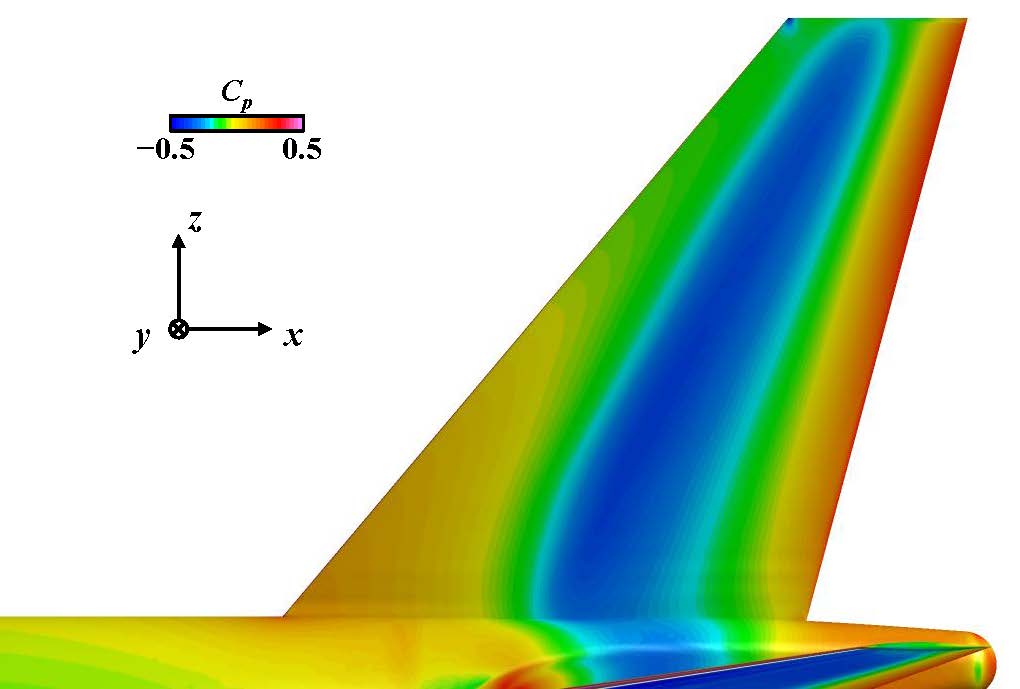Research on laminar fins system
JAXA Supercomputer System Annual Report February 2024-January 2025
Report Number: R24EA0601
Subject Category: Aeronautical Technology
- Responsible Representative: Dongyoun Kwak, Hub Maneger, Aviation Environmental Sustainability Innovation Hub/Aviation Technology Directorate
- Contact Information: Naoko Tokugawa(tokugawa.naoko@jaxa.jp)
- Members: Takahiro Ishida, Fumitake Kuroda, Keisuke Ohira, Naoko Tokugawa, Kaito Tamazaki, Keiji Ueshima, Hayahide Yoshida
Abstract
The laminar flow vertical tail fins is designed and evaluated to develop practical technology for natural laminar flow wings in future subsonic aircraft. By analysing the effects of surface roughness on the flow field, we aim to define criteria for surface roughness that preserve laminar flow characteristics.
Reference URL
Please refer to 'Innovative Green Aircraft Technology (iGreen) | Sky Green+ | Aviation Technology Directorate'.
Reasons and benefits of using JAXA Supercomputer System
The design of laminar airfoils to reduce aircraft fuel consumption requires rapid develpment processes and extensive high-precision fluid flow analyses to examine fine details of boundary layer flows. Surface roughness analysis demands even more detailed investigation than standard design requirements. To accomplish these tasks, the use of supercomputer is essential.
Achievements of the Year
To summarize the achievements of this research project, the developed laminar flow wing design technology was applied to the entire aircraft design. At the Aeronautical Technology Directorate of JAXA, a target pressure distribution that sustains the boundary layer in a laminar state was predefined, and an inverse design method was used to develop a wing shape that achieves this distribution. As a result, this approach successfully attained a laminar flow surface coverage of 46.2% while preserving control effectiveness comparable to that of a conventional (non-laminar) wing. Even when accounting for the effects of surface roughness, which is being investigated separately, fuel consumption is estimated to be reduced by approximately 0.8%.

Fig.1: Pressure distribution on the laminar flow vertical tail under the assumed flight conditions of the entire aircraft (M = 0.78, altitude 35,000 ft).
Publications
- Peer-reviewed papers
N. Tokugawa, T. Ishida, K. Ueshima, K. Ohira,"Demonstration of Natural Laminar Vertical Tail at Flight Reynolds Number in ETW", submitted to Proc. of Tenth IUTAM Symposium on Laminar-Turbulent Transition (IUTAM LTT 2024)
Usage of JSS
Computational Information
- Process Parallelization Methods: MPI
- Thread Parallelization Methods: Automatic Parallelization
- Number of Processes: 48 - 10008
- Elapsed Time per Case: 55 Hour(s)
JSS3 Resources Used
Fraction of Usage in Total Resources*1(%): 4.62
Details
Please refer to System Configuration of JSS3 for the system configuration and major specifications of JSS3.
| System Name | CPU Resources Used(Core x Hours) | Fraction of Usage*2(%) |
|---|---|---|
| TOKI-SORA | 120676785.17 | 5.52 |
| TOKI-ST | 106641.68 | 0.11 |
| TOKI-GP | 118399.89 | 1.82 |
| TOKI-XM | 52472.88 | 25.54 |
| TOKI-LM | 79402.19 | 5.73 |
| TOKI-TST | 223.79 | 0.00 |
| TOKI-TGP | 0.00 | 0.00 |
| TOKI-TLM | 0.00 | 0.00 |
| File System Name | Storage Assigned(GiB) | Fraction of Usage*2(%) |
|---|---|---|
| /home | 1276.39 | 0.86 |
| /data and /data2 | 235373.41 | 1.13 |
| /ssd | 14958.00 | 0.80 |
| Archiver Name | Storage Used(TiB) | Fraction of Usage*2(%) |
|---|---|---|
| J-SPACE | 28.13 | 0.09 |
*1: Fraction of Usage in Total Resources: Weighted average of three resource types (Computing, File System, and Archiver).
*2: Fraction of Usage:Percentage of usage relative to each resource used in one year.
ISV Software Licenses Used
| ISV Software Licenses Used(Hours) | Fraction of Usage*2(%) | |
|---|---|---|
| ISV Software Licenses(Total) | 3444.38 | 2.35 |
*2: Fraction of Usage:Percentage of usage relative to each resource used in one year.
JAXA Supercomputer System Annual Report February 2024-January 2025


